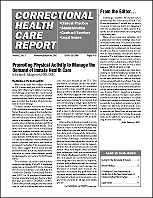Worth Reading
Author: Margaret R. Moreland, J.D., M.S.L.S..
Source: Volume 20, Number 04, May/June 2019 , pp.54-57(4)

< previous article |next article > |return to table of contents
Abstract:
Our regular review of the research literature features three studies: one that found the greatest barriers to accessing health care while in custody were related to communication difficulties; one that determined that over 9% of eligible out-of-prison deaths were attributable to opioid overdoses and that rates were highest in the two weeks following release; and a third that addresses methods of dealing with malnutrition—both under- and over-nutrition—a common condition in correctional facilities, and a major cause of morbidity and mortality. Reviewed: “‘Imagine If I’m Not Here, What They’re Going to Do?’—Health-Care Access and Culturally and Linguistically Diverse Women in Prison” by Kelly Watt, Wendy Hu, Parker Magin, and Penny Abbott, published in 21 Health Expectations 1159 (2018); “Opioid Overdose Mortality Among Former North Carolina Inmates: 2000–2015” by Shabbar I. Ranapurwala, Meghan E. Shanahan, Apostolos A. Alexandridis, Scott K. Proescholdbell, Rebecca B. Naumann, Daniel Edwards Jr, and Stephen W. Marshall, published in 108 American Journal of Public Health 1207 (2018); “Medical Nutrition Therapy in Canadian Federal Correctional Facilities” by Karen M. Davison, Carla D’Andreamatteo, and Victoria L. Smye, published in 19 BMC Health Services Research 89 (2019).Keywords: Language Barriers to Health Care; Opioid Mortality; Medical Nutrition Therapy
Affiliations:
1: Pace University School of Law.